Detailed Case Study: Developing a Fixed Income Portfolio for a Client
VerifiedAdded on 2022/11/19
|29
|5723
|466
Case Study
AI Summary
This case study presents a comprehensive analysis of a fixed income portfolio developed for a Russian client residing in Switzerland, with the primary objective of mitigating the impact of inflation. The report begins by outlining the investment strategy, including the selection of specific securities and the rationale behind these choices. The approach emphasizes a top-down systematic method, considering factors such as interest rates, yield curves, expropriation risks, and default rates. The selected funds include JPMorgan Ultra-Short Income ETF (JPST), Federated High Income Bond Fund (FHIIX), SPDR Blackstone/GSO Senior Loan ETF (SRLN), and Vanguard Intermediate-Term Bond Index (VBILX), each chosen for its specific risk-return profile and contribution to portfolio diversification. The justification for the strategy focuses on the importance of fixed income components in uncertain markets and the need to balance risk and returns, especially in an environment of low inflation and interest rates. The action plan emphasizes a disciplined approach to investment, focusing on controlling potential losses and enhancing financial success through careful selection of bonds and continuous monitoring of market dynamics. The study also discusses strategies for selecting and avoiding certain types of bonds to achieve diversification and desired returns.
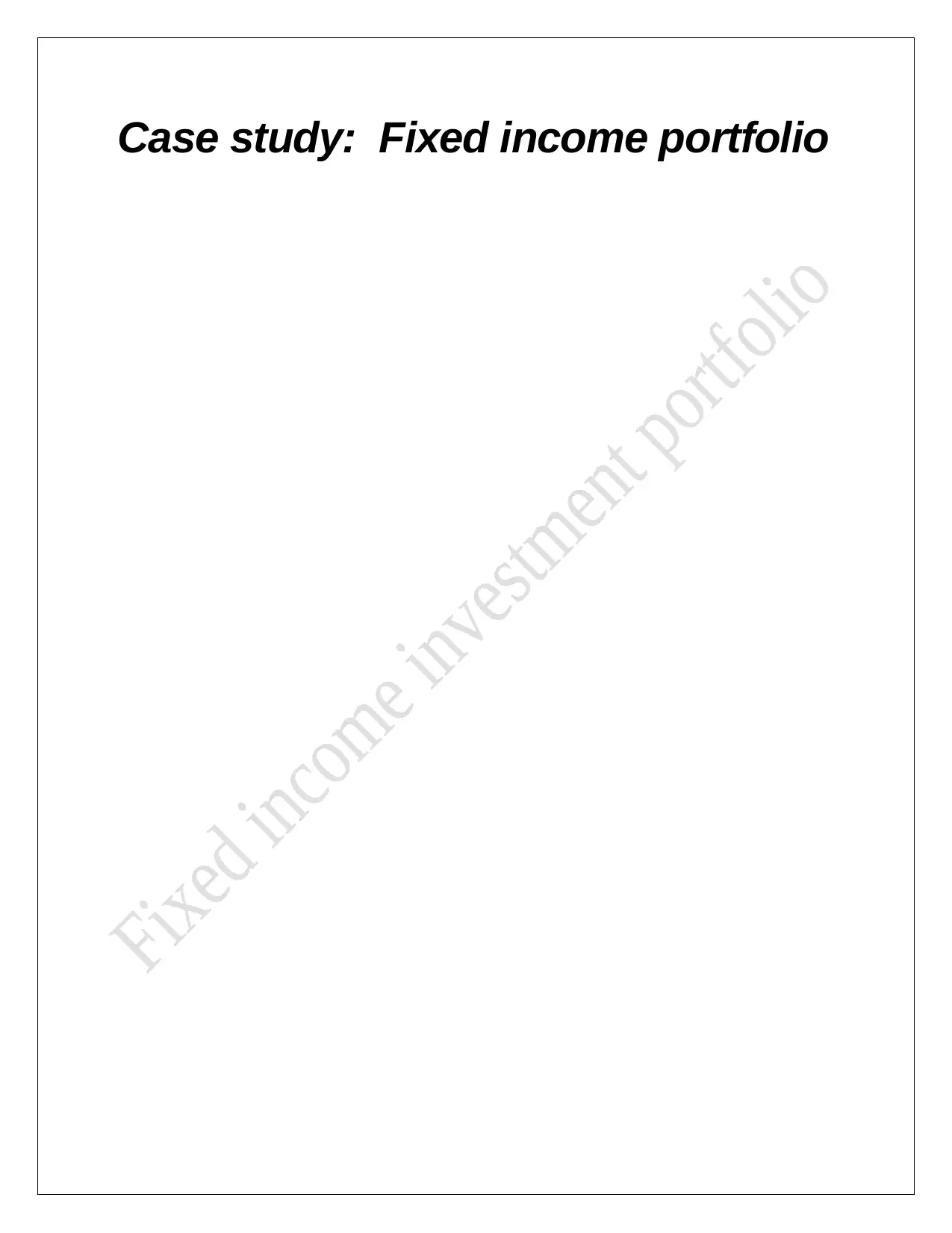
Case study: Fixed income portfolio
Paraphrase This Document
Need a fresh take? Get an instant paraphrase of this document with our AI Paraphraser
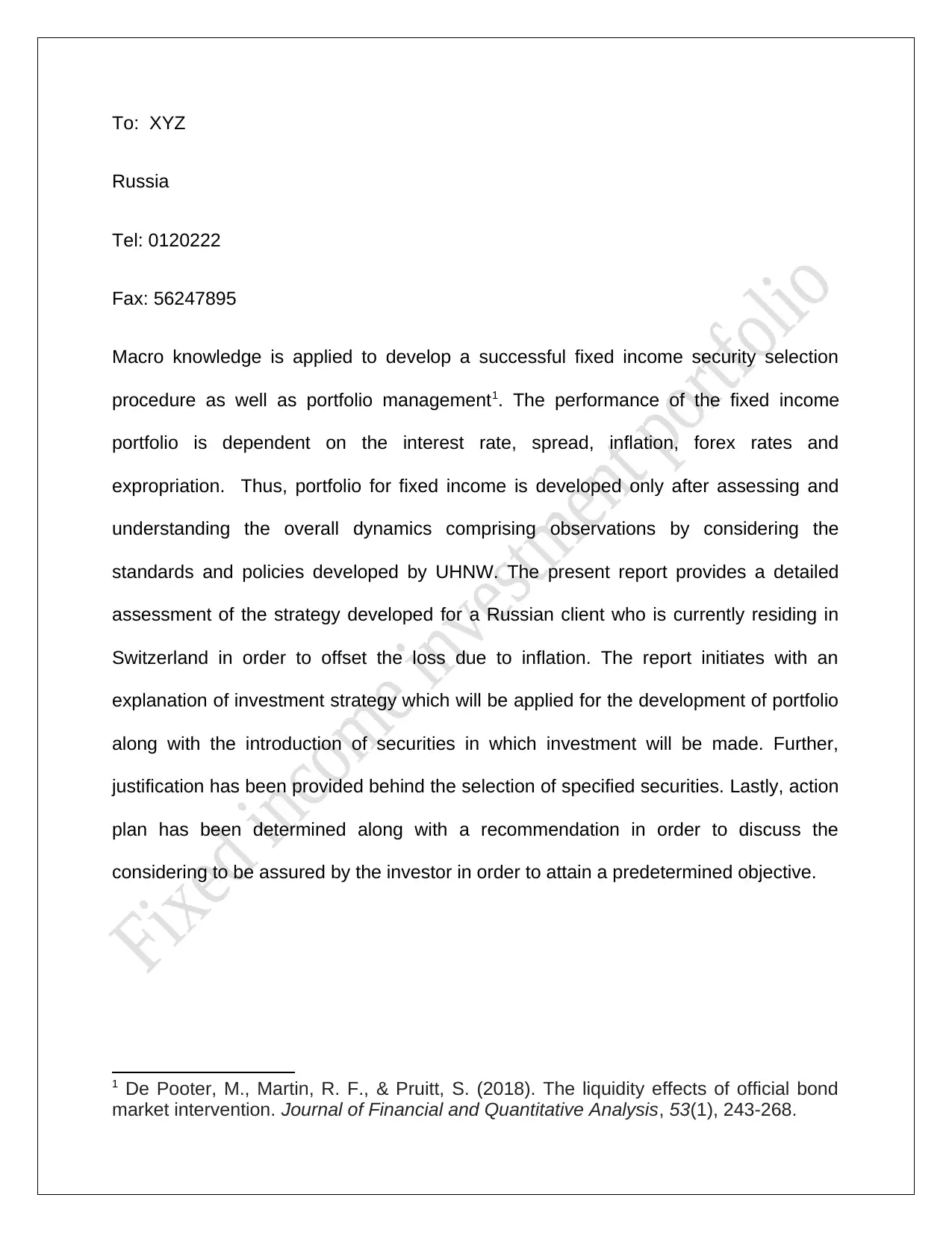
To: XYZ
Russia
Tel: 0120222
Fax: 56247895
Macro knowledge is applied to develop a successful fixed income security selection
procedure as well as portfolio management1. The performance of the fixed income
portfolio is dependent on the interest rate, spread, inflation, forex rates and
expropriation. Thus, portfolio for fixed income is developed only after assessing and
understanding the overall dynamics comprising observations by considering the
standards and policies developed by UHNW. The present report provides a detailed
assessment of the strategy developed for a Russian client who is currently residing in
Switzerland in order to offset the loss due to inflation. The report initiates with an
explanation of investment strategy which will be applied for the development of portfolio
along with the introduction of securities in which investment will be made. Further,
justification has been provided behind the selection of specified securities. Lastly, action
plan has been determined along with a recommendation in order to discuss the
considering to be assured by the investor in order to attain a predetermined objective.
1 De Pooter, M., Martin, R. F., & Pruitt, S. (2018). The liquidity effects of official bond
market intervention. Journal of Financial and Quantitative Analysis, 53(1), 243-268.
Russia
Tel: 0120222
Fax: 56247895
Macro knowledge is applied to develop a successful fixed income security selection
procedure as well as portfolio management1. The performance of the fixed income
portfolio is dependent on the interest rate, spread, inflation, forex rates and
expropriation. Thus, portfolio for fixed income is developed only after assessing and
understanding the overall dynamics comprising observations by considering the
standards and policies developed by UHNW. The present report provides a detailed
assessment of the strategy developed for a Russian client who is currently residing in
Switzerland in order to offset the loss due to inflation. The report initiates with an
explanation of investment strategy which will be applied for the development of portfolio
along with the introduction of securities in which investment will be made. Further,
justification has been provided behind the selection of specified securities. Lastly, action
plan has been determined along with a recommendation in order to discuss the
considering to be assured by the investor in order to attain a predetermined objective.
1 De Pooter, M., Martin, R. F., & Pruitt, S. (2018). The liquidity effects of official bond
market intervention. Journal of Financial and Quantitative Analysis, 53(1), 243-268.
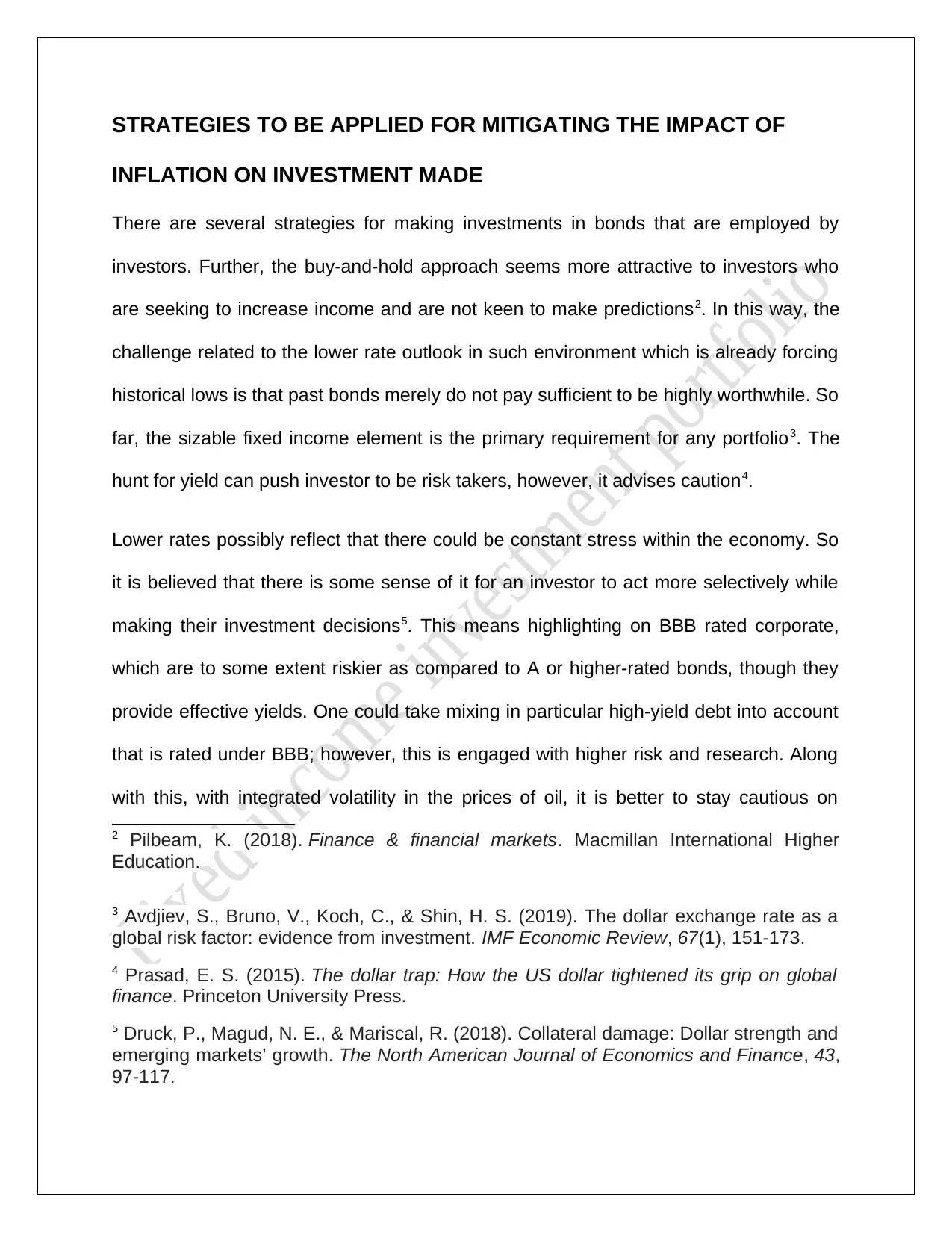
STRATEGIES TO BE APPLIED FOR MITIGATING THE IMPACT OF
INFLATION ON INVESTMENT MADE
There are several strategies for making investments in bonds that are employed by
investors. Further, the buy-and-hold approach seems more attractive to investors who
are seeking to increase income and are not keen to make predictions2. In this way, the
challenge related to the lower rate outlook in such environment which is already forcing
historical lows is that past bonds merely do not pay sufficient to be highly worthwhile. So
far, the sizable fixed income element is the primary requirement for any portfolio3. The
hunt for yield can push investor to be risk takers, however, it advises caution4.
Lower rates possibly reflect that there could be constant stress within the economy. So
it is believed that there is some sense of it for an investor to act more selectively while
making their investment decisions5. This means highlighting on BBB rated corporate,
which are to some extent riskier as compared to A or higher-rated bonds, though they
provide effective yields. One could take mixing in particular high-yield debt into account
that is rated under BBB; however, this is engaged with higher risk and research. Along
with this, with integrated volatility in the prices of oil, it is better to stay cautious on
2 Pilbeam, K. (2018). Finance & financial markets. Macmillan International Higher
Education.
3 Avdjiev, S., Bruno, V., Koch, C., & Shin, H. S. (2019). The dollar exchange rate as a
global risk factor: evidence from investment. IMF Economic Review, 67(1), 151-173.
4 Prasad, E. S. (2015). The dollar trap: How the US dollar tightened its grip on global
finance. Princeton University Press.
5 Druck, P., Magud, N. E., & Mariscal, R. (2018). Collateral damage: Dollar strength and
emerging markets’ growth. The North American Journal of Economics and Finance, 43,
97-117.
INFLATION ON INVESTMENT MADE
There are several strategies for making investments in bonds that are employed by
investors. Further, the buy-and-hold approach seems more attractive to investors who
are seeking to increase income and are not keen to make predictions2. In this way, the
challenge related to the lower rate outlook in such environment which is already forcing
historical lows is that past bonds merely do not pay sufficient to be highly worthwhile. So
far, the sizable fixed income element is the primary requirement for any portfolio3. The
hunt for yield can push investor to be risk takers, however, it advises caution4.
Lower rates possibly reflect that there could be constant stress within the economy. So
it is believed that there is some sense of it for an investor to act more selectively while
making their investment decisions5. This means highlighting on BBB rated corporate,
which are to some extent riskier as compared to A or higher-rated bonds, though they
provide effective yields. One could take mixing in particular high-yield debt into account
that is rated under BBB; however, this is engaged with higher risk and research. Along
with this, with integrated volatility in the prices of oil, it is better to stay cautious on
2 Pilbeam, K. (2018). Finance & financial markets. Macmillan International Higher
Education.
3 Avdjiev, S., Bruno, V., Koch, C., & Shin, H. S. (2019). The dollar exchange rate as a
global risk factor: evidence from investment. IMF Economic Review, 67(1), 151-173.
4 Prasad, E. S. (2015). The dollar trap: How the US dollar tightened its grip on global
finance. Princeton University Press.
5 Druck, P., Magud, N. E., & Mariscal, R. (2018). Collateral damage: Dollar strength and
emerging markets’ growth. The North American Journal of Economics and Finance, 43,
97-117.
⊘ This is a preview!⊘
Do you want full access?
Subscribe today to unlock all pages.

Trusted by 1+ million students worldwide
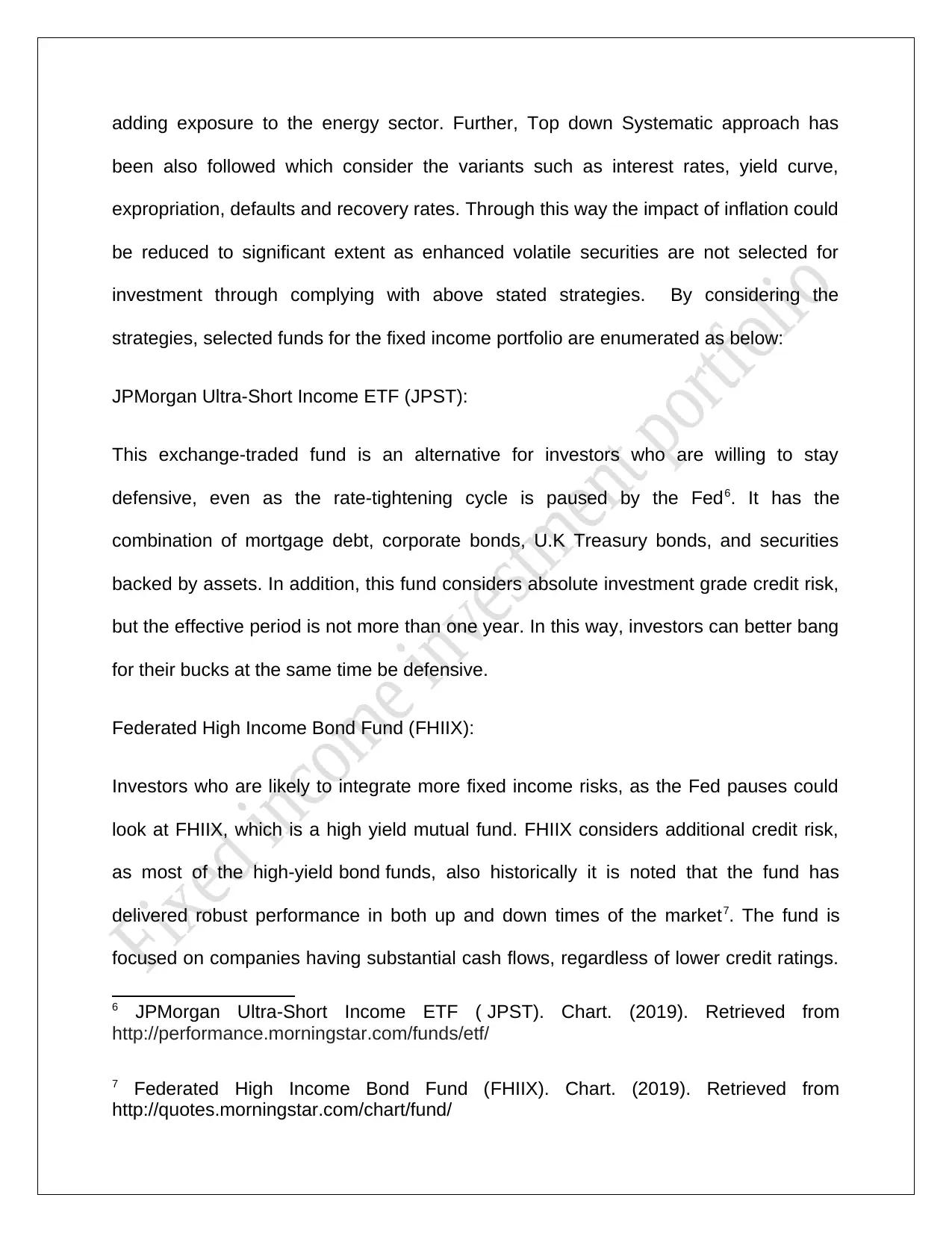
adding exposure to the energy sector. Further, Top down Systematic approach has
been also followed which consider the variants such as interest rates, yield curve,
expropriation, defaults and recovery rates. Through this way the impact of inflation could
be reduced to significant extent as enhanced volatile securities are not selected for
investment through complying with above stated strategies. By considering the
strategies, selected funds for the fixed income portfolio are enumerated as below:
JPMorgan Ultra-Short Income ETF (JPST):
This exchange-traded fund is an alternative for investors who are willing to stay
defensive, even as the rate-tightening cycle is paused by the Fed6. It has the
combination of mortgage debt, corporate bonds, U.K Treasury bonds, and securities
backed by assets. In addition, this fund considers absolute investment grade credit risk,
but the effective period is not more than one year. In this way, investors can better bang
for their bucks at the same time be defensive.
Federated High Income Bond Fund (FHIIX):
Investors who are likely to integrate more fixed income risks, as the Fed pauses could
look at FHIIX, which is a high yield mutual fund. FHIIX considers additional credit risk,
as most of the high-yield bond funds, also historically it is noted that the fund has
delivered robust performance in both up and down times of the market7. The fund is
focused on companies having substantial cash flows, regardless of lower credit ratings.
6 JPMorgan Ultra-Short Income ETF ( JPST). Chart. (2019). Retrieved from
http://performance.morningstar.com/funds/etf/
7 Federated High Income Bond Fund (FHIIX). Chart. (2019). Retrieved from
http://quotes.morningstar.com/chart/fund/
been also followed which consider the variants such as interest rates, yield curve,
expropriation, defaults and recovery rates. Through this way the impact of inflation could
be reduced to significant extent as enhanced volatile securities are not selected for
investment through complying with above stated strategies. By considering the
strategies, selected funds for the fixed income portfolio are enumerated as below:
JPMorgan Ultra-Short Income ETF (JPST):
This exchange-traded fund is an alternative for investors who are willing to stay
defensive, even as the rate-tightening cycle is paused by the Fed6. It has the
combination of mortgage debt, corporate bonds, U.K Treasury bonds, and securities
backed by assets. In addition, this fund considers absolute investment grade credit risk,
but the effective period is not more than one year. In this way, investors can better bang
for their bucks at the same time be defensive.
Federated High Income Bond Fund (FHIIX):
Investors who are likely to integrate more fixed income risks, as the Fed pauses could
look at FHIIX, which is a high yield mutual fund. FHIIX considers additional credit risk,
as most of the high-yield bond funds, also historically it is noted that the fund has
delivered robust performance in both up and down times of the market7. The fund is
focused on companies having substantial cash flows, regardless of lower credit ratings.
6 JPMorgan Ultra-Short Income ETF ( JPST). Chart. (2019). Retrieved from
http://performance.morningstar.com/funds/etf/
7 Federated High Income Bond Fund (FHIIX). Chart. (2019). Retrieved from
http://quotes.morningstar.com/chart/fund/
Paraphrase This Document
Need a fresh take? Get an instant paraphrase of this document with our AI Paraphraser
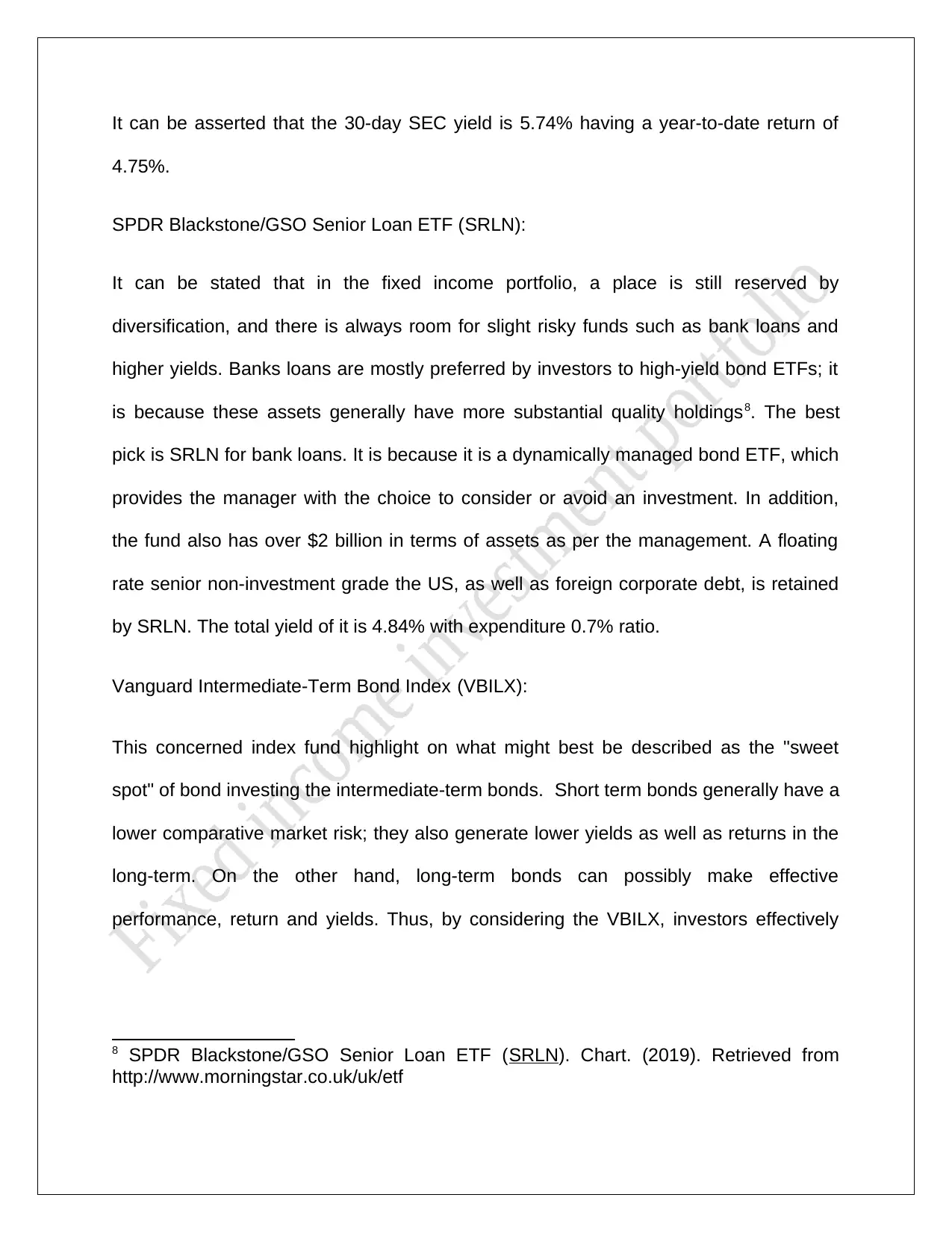
It can be asserted that the 30-day SEC yield is 5.74% having a year-to-date return of
4.75%.
SPDR Blackstone/GSO Senior Loan ETF (SRLN):
It can be stated that in the fixed income portfolio, a place is still reserved by
diversification, and there is always room for slight risky funds such as bank loans and
higher yields. Banks loans are mostly preferred by investors to high-yield bond ETFs; it
is because these assets generally have more substantial quality holdings8. The best
pick is SRLN for bank loans. It is because it is a dynamically managed bond ETF, which
provides the manager with the choice to consider or avoid an investment. In addition,
the fund also has over $2 billion in terms of assets as per the management. A floating
rate senior non-investment grade the US, as well as foreign corporate debt, is retained
by SRLN. The total yield of it is 4.84% with expenditure 0.7% ratio.
Vanguard Intermediate-Term Bond Index (VBILX):
This concerned index fund highlight on what might best be described as the "sweet
spot" of bond investing the intermediate-term bonds. Short term bonds generally have a
lower comparative market risk; they also generate lower yields as well as returns in the
long-term. On the other hand, long-term bonds can possibly make effective
performance, return and yields. Thus, by considering the VBILX, investors effectively
8 SPDR Blackstone/GSO Senior Loan ETF (SRLN). Chart. (2019). Retrieved from
http://www.morningstar.co.uk/uk/etf
4.75%.
SPDR Blackstone/GSO Senior Loan ETF (SRLN):
It can be stated that in the fixed income portfolio, a place is still reserved by
diversification, and there is always room for slight risky funds such as bank loans and
higher yields. Banks loans are mostly preferred by investors to high-yield bond ETFs; it
is because these assets generally have more substantial quality holdings8. The best
pick is SRLN for bank loans. It is because it is a dynamically managed bond ETF, which
provides the manager with the choice to consider or avoid an investment. In addition,
the fund also has over $2 billion in terms of assets as per the management. A floating
rate senior non-investment grade the US, as well as foreign corporate debt, is retained
by SRLN. The total yield of it is 4.84% with expenditure 0.7% ratio.
Vanguard Intermediate-Term Bond Index (VBILX):
This concerned index fund highlight on what might best be described as the "sweet
spot" of bond investing the intermediate-term bonds. Short term bonds generally have a
lower comparative market risk; they also generate lower yields as well as returns in the
long-term. On the other hand, long-term bonds can possibly make effective
performance, return and yields. Thus, by considering the VBILX, investors effectively
8 SPDR Blackstone/GSO Senior Loan ETF (SRLN). Chart. (2019). Retrieved from
http://www.morningstar.co.uk/uk/etf
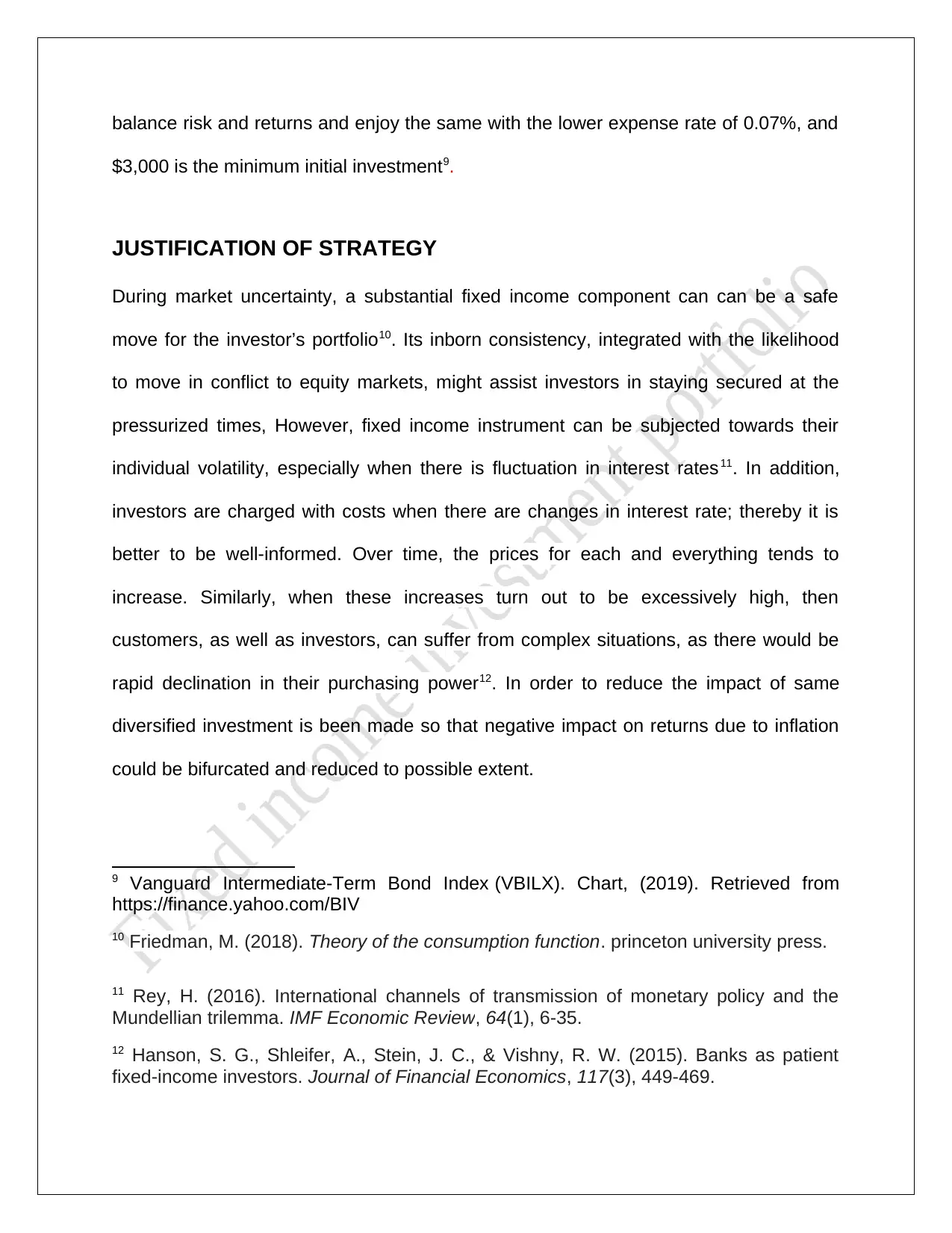
balance risk and returns and enjoy the same with the lower expense rate of 0.07%, and
$3,000 is the minimum initial investment9.
JUSTIFICATION OF STRATEGY
During market uncertainty, a substantial fixed income component can can be a safe
move for the investor’s portfolio10. Its inborn consistency, integrated with the likelihood
to move in conflict to equity markets, might assist investors in staying secured at the
pressurized times, However, fixed income instrument can be subjected towards their
individual volatility, especially when there is fluctuation in interest rates11. In addition,
investors are charged with costs when there are changes in interest rate; thereby it is
better to be well-informed. Over time, the prices for each and everything tends to
increase. Similarly, when these increases turn out to be excessively high, then
customers, as well as investors, can suffer from complex situations, as there would be
rapid declination in their purchasing power12. In order to reduce the impact of same
diversified investment is been made so that negative impact on returns due to inflation
could be bifurcated and reduced to possible extent.
9 Vanguard Intermediate-Term Bond Index (VBILX). Chart, (2019). Retrieved from
https://finance.yahoo.com/BIV
10 Friedman, M. (2018). Theory of the consumption function. princeton university press.
11 Rey, H. (2016). International channels of transmission of monetary policy and the
Mundellian trilemma. IMF Economic Review, 64(1), 6-35.
12 Hanson, S. G., Shleifer, A., Stein, J. C., & Vishny, R. W. (2015). Banks as patient
fixed-income investors. Journal of Financial Economics, 117(3), 449-469.
$3,000 is the minimum initial investment9.
JUSTIFICATION OF STRATEGY
During market uncertainty, a substantial fixed income component can can be a safe
move for the investor’s portfolio10. Its inborn consistency, integrated with the likelihood
to move in conflict to equity markets, might assist investors in staying secured at the
pressurized times, However, fixed income instrument can be subjected towards their
individual volatility, especially when there is fluctuation in interest rates11. In addition,
investors are charged with costs when there are changes in interest rate; thereby it is
better to be well-informed. Over time, the prices for each and everything tends to
increase. Similarly, when these increases turn out to be excessively high, then
customers, as well as investors, can suffer from complex situations, as there would be
rapid declination in their purchasing power12. In order to reduce the impact of same
diversified investment is been made so that negative impact on returns due to inflation
could be bifurcated and reduced to possible extent.
9 Vanguard Intermediate-Term Bond Index (VBILX). Chart, (2019). Retrieved from
https://finance.yahoo.com/BIV
10 Friedman, M. (2018). Theory of the consumption function. princeton university press.
11 Rey, H. (2016). International channels of transmission of monetary policy and the
Mundellian trilemma. IMF Economic Review, 64(1), 6-35.
12 Hanson, S. G., Shleifer, A., Stein, J. C., & Vishny, R. W. (2015). Banks as patient
fixed-income investors. Journal of Financial Economics, 117(3), 449-469.
⊘ This is a preview!⊘
Do you want full access?
Subscribe today to unlock all pages.

Trusted by 1+ million students worldwide
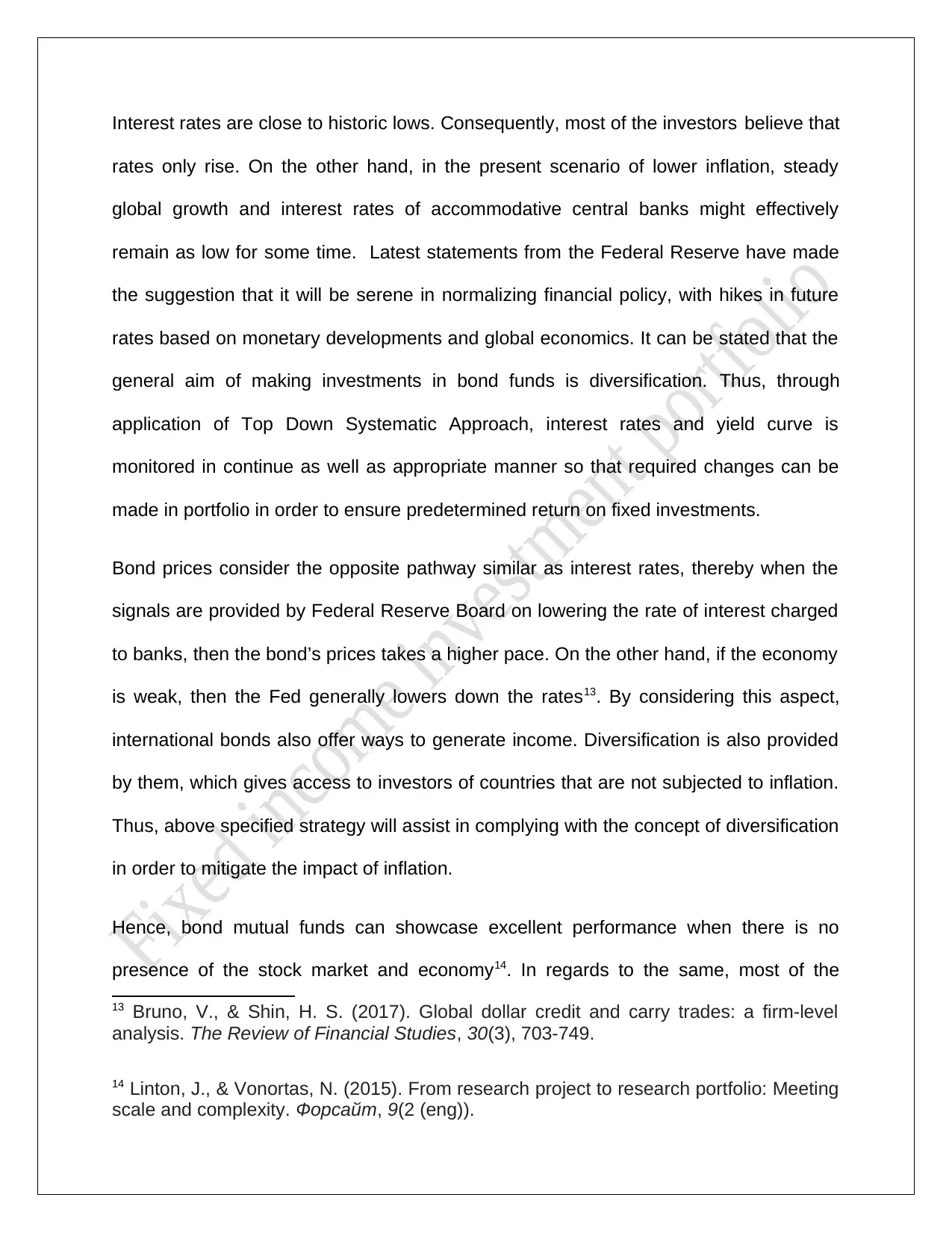
Interest rates are close to historic lows. Consequently, most of the investors believe that
rates only rise. On the other hand, in the present scenario of lower inflation, steady
global growth and interest rates of accommodative central banks might effectively
remain as low for some time. Latest statements from the Federal Reserve have made
the suggestion that it will be serene in normalizing financial policy, with hikes in future
rates based on monetary developments and global economics. It can be stated that the
general aim of making investments in bond funds is diversification. Thus, through
application of Top Down Systematic Approach, interest rates and yield curve is
monitored in continue as well as appropriate manner so that required changes can be
made in portfolio in order to ensure predetermined return on fixed investments.
Bond prices consider the opposite pathway similar as interest rates, thereby when the
signals are provided by Federal Reserve Board on lowering the rate of interest charged
to banks, then the bond’s prices takes a higher pace. On the other hand, if the economy
is weak, then the Fed generally lowers down the rates13. By considering this aspect,
international bonds also offer ways to generate income. Diversification is also provided
by them, which gives access to investors of countries that are not subjected to inflation.
Thus, above specified strategy will assist in complying with the concept of diversification
in order to mitigate the impact of inflation.
Hence, bond mutual funds can showcase excellent performance when there is no
presence of the stock market and economy14. In regards to the same, most of the
13 Bruno, V., & Shin, H. S. (2017). Global dollar credit and carry trades: a firm-level
analysis. The Review of Financial Studies, 30(3), 703-749.
14 Linton, J., & Vonortas, N. (2015). From research project to research portfolio: Meeting
scale and complexity. Форсайт, 9(2 (eng)).
rates only rise. On the other hand, in the present scenario of lower inflation, steady
global growth and interest rates of accommodative central banks might effectively
remain as low for some time. Latest statements from the Federal Reserve have made
the suggestion that it will be serene in normalizing financial policy, with hikes in future
rates based on monetary developments and global economics. It can be stated that the
general aim of making investments in bond funds is diversification. Thus, through
application of Top Down Systematic Approach, interest rates and yield curve is
monitored in continue as well as appropriate manner so that required changes can be
made in portfolio in order to ensure predetermined return on fixed investments.
Bond prices consider the opposite pathway similar as interest rates, thereby when the
signals are provided by Federal Reserve Board on lowering the rate of interest charged
to banks, then the bond’s prices takes a higher pace. On the other hand, if the economy
is weak, then the Fed generally lowers down the rates13. By considering this aspect,
international bonds also offer ways to generate income. Diversification is also provided
by them, which gives access to investors of countries that are not subjected to inflation.
Thus, above specified strategy will assist in complying with the concept of diversification
in order to mitigate the impact of inflation.
Hence, bond mutual funds can showcase excellent performance when there is no
presence of the stock market and economy14. In regards to the same, most of the
13 Bruno, V., & Shin, H. S. (2017). Global dollar credit and carry trades: a firm-level
analysis. The Review of Financial Studies, 30(3), 703-749.
14 Linton, J., & Vonortas, N. (2015). From research project to research portfolio: Meeting
scale and complexity. Форсайт, 9(2 (eng)).
Paraphrase This Document
Need a fresh take? Get an instant paraphrase of this document with our AI Paraphraser
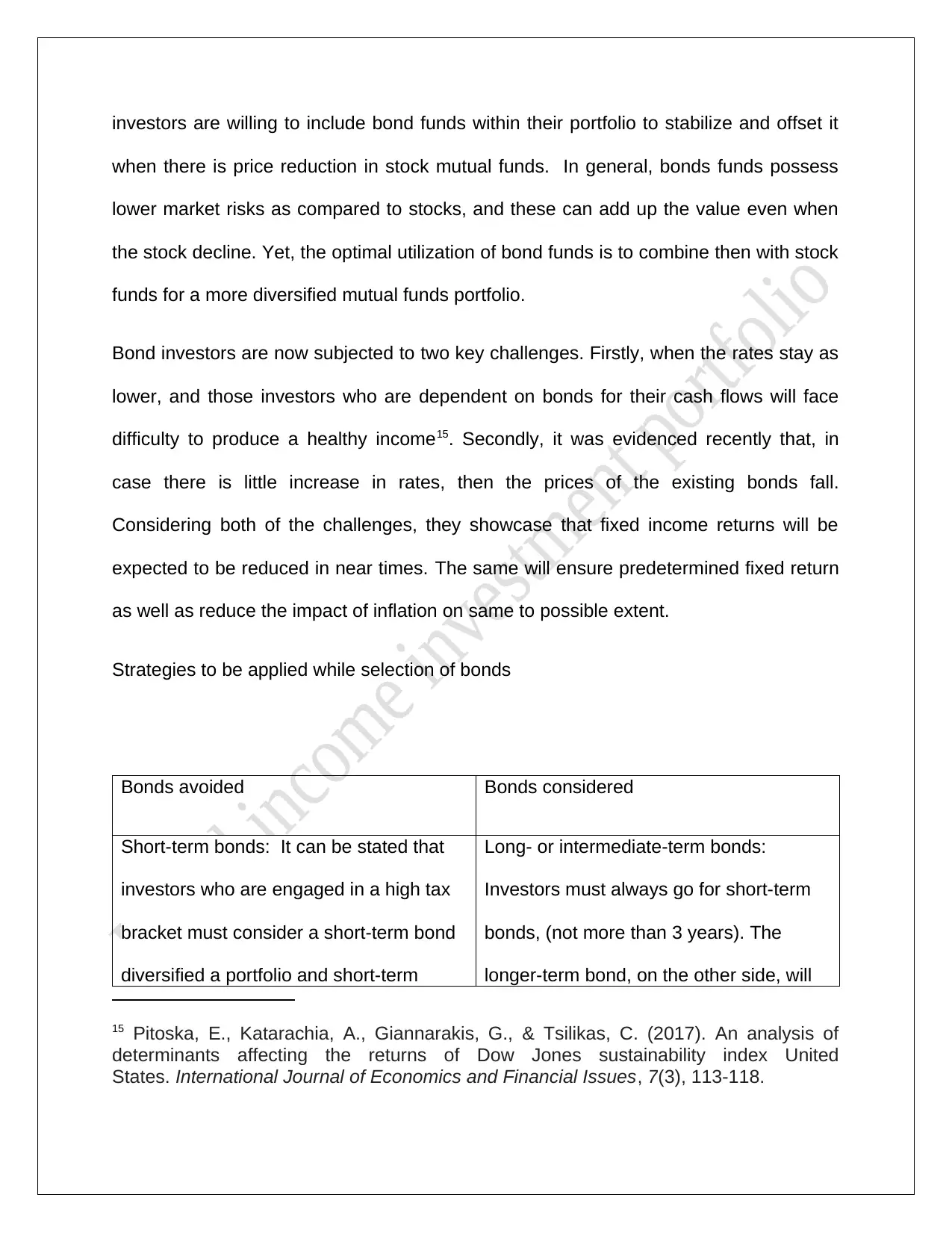
investors are willing to include bond funds within their portfolio to stabilize and offset it
when there is price reduction in stock mutual funds. In general, bonds funds possess
lower market risks as compared to stocks, and these can add up the value even when
the stock decline. Yet, the optimal utilization of bond funds is to combine then with stock
funds for a more diversified mutual funds portfolio.
Bond investors are now subjected to two key challenges. Firstly, when the rates stay as
lower, and those investors who are dependent on bonds for their cash flows will face
difficulty to produce a healthy income15. Secondly, it was evidenced recently that, in
case there is little increase in rates, then the prices of the existing bonds fall.
Considering both of the challenges, they showcase that fixed income returns will be
expected to be reduced in near times. The same will ensure predetermined fixed return
as well as reduce the impact of inflation on same to possible extent.
Strategies to be applied while selection of bonds
Bonds avoided Bonds considered
Short-term bonds: It can be stated that
investors who are engaged in a high tax
bracket must consider a short-term bond
diversified a portfolio and short-term
Long- or intermediate-term bonds:
Investors must always go for short-term
bonds, (not more than 3 years). The
longer-term bond, on the other side, will
15 Pitoska, E., Katarachia, A., Giannarakis, G., & Tsilikas, C. (2017). An analysis of
determinants affecting the returns of Dow Jones sustainability index United
States. International Journal of Economics and Financial Issues, 7(3), 113-118.
when there is price reduction in stock mutual funds. In general, bonds funds possess
lower market risks as compared to stocks, and these can add up the value even when
the stock decline. Yet, the optimal utilization of bond funds is to combine then with stock
funds for a more diversified mutual funds portfolio.
Bond investors are now subjected to two key challenges. Firstly, when the rates stay as
lower, and those investors who are dependent on bonds for their cash flows will face
difficulty to produce a healthy income15. Secondly, it was evidenced recently that, in
case there is little increase in rates, then the prices of the existing bonds fall.
Considering both of the challenges, they showcase that fixed income returns will be
expected to be reduced in near times. The same will ensure predetermined fixed return
as well as reduce the impact of inflation on same to possible extent.
Strategies to be applied while selection of bonds
Bonds avoided Bonds considered
Short-term bonds: It can be stated that
investors who are engaged in a high tax
bracket must consider a short-term bond
diversified a portfolio and short-term
Long- or intermediate-term bonds:
Investors must always go for short-term
bonds, (not more than 3 years). The
longer-term bond, on the other side, will
15 Pitoska, E., Katarachia, A., Giannarakis, G., & Tsilikas, C. (2017). An analysis of
determinants affecting the returns of Dow Jones sustainability index United
States. International Journal of Economics and Financial Issues, 7(3), 113-118.
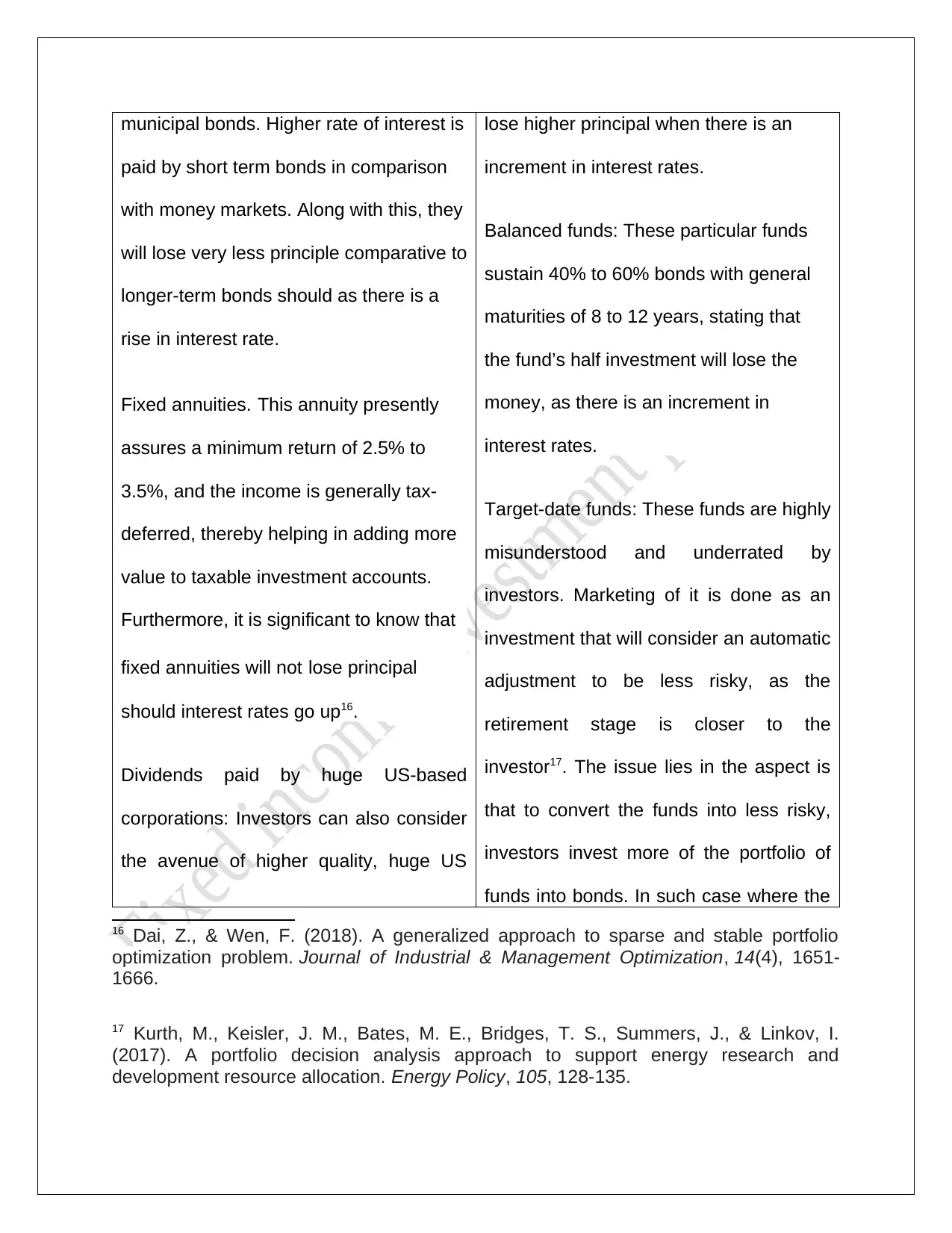
municipal bonds. Higher rate of interest is
paid by short term bonds in comparison
with money markets. Along with this, they
will lose very less principle comparative to
longer-term bonds should as there is a
rise in interest rate.
Fixed annuities. This annuity presently
assures a minimum return of 2.5% to
3.5%, and the income is generally tax-
deferred, thereby helping in adding more
value to taxable investment accounts.
Furthermore, it is significant to know that
fixed annuities will not lose principal
should interest rates go up16.
Dividends paid by huge US-based
corporations: Investors can also consider
the avenue of higher quality, huge US
lose higher principal when there is an
increment in interest rates.
Balanced funds: These particular funds
sustain 40% to 60% bonds with general
maturities of 8 to 12 years, stating that
the fund’s half investment will lose the
money, as there is an increment in
interest rates.
Target-date funds: These funds are highly
misunderstood and underrated by
investors. Marketing of it is done as an
investment that will consider an automatic
adjustment to be less risky, as the
retirement stage is closer to the
investor17. The issue lies in the aspect is
that to convert the funds into less risky,
investors invest more of the portfolio of
funds into bonds. In such case where the
16 Dai, Z., & Wen, F. (2018). A generalized approach to sparse and stable portfolio
optimization problem. Journal of Industrial & Management Optimization, 14(4), 1651-
1666.
17 Kurth, M., Keisler, J. M., Bates, M. E., Bridges, T. S., Summers, J., & Linkov, I.
(2017). A portfolio decision analysis approach to support energy research and
development resource allocation. Energy Policy, 105, 128-135.
paid by short term bonds in comparison
with money markets. Along with this, they
will lose very less principle comparative to
longer-term bonds should as there is a
rise in interest rate.
Fixed annuities. This annuity presently
assures a minimum return of 2.5% to
3.5%, and the income is generally tax-
deferred, thereby helping in adding more
value to taxable investment accounts.
Furthermore, it is significant to know that
fixed annuities will not lose principal
should interest rates go up16.
Dividends paid by huge US-based
corporations: Investors can also consider
the avenue of higher quality, huge US
lose higher principal when there is an
increment in interest rates.
Balanced funds: These particular funds
sustain 40% to 60% bonds with general
maturities of 8 to 12 years, stating that
the fund’s half investment will lose the
money, as there is an increment in
interest rates.
Target-date funds: These funds are highly
misunderstood and underrated by
investors. Marketing of it is done as an
investment that will consider an automatic
adjustment to be less risky, as the
retirement stage is closer to the
investor17. The issue lies in the aspect is
that to convert the funds into less risky,
investors invest more of the portfolio of
funds into bonds. In such case where the
16 Dai, Z., & Wen, F. (2018). A generalized approach to sparse and stable portfolio
optimization problem. Journal of Industrial & Management Optimization, 14(4), 1651-
1666.
17 Kurth, M., Keisler, J. M., Bates, M. E., Bridges, T. S., Summers, J., & Linkov, I.
(2017). A portfolio decision analysis approach to support energy research and
development resource allocation. Energy Policy, 105, 128-135.
⊘ This is a preview!⊘
Do you want full access?
Subscribe today to unlock all pages.

Trusted by 1+ million students worldwide
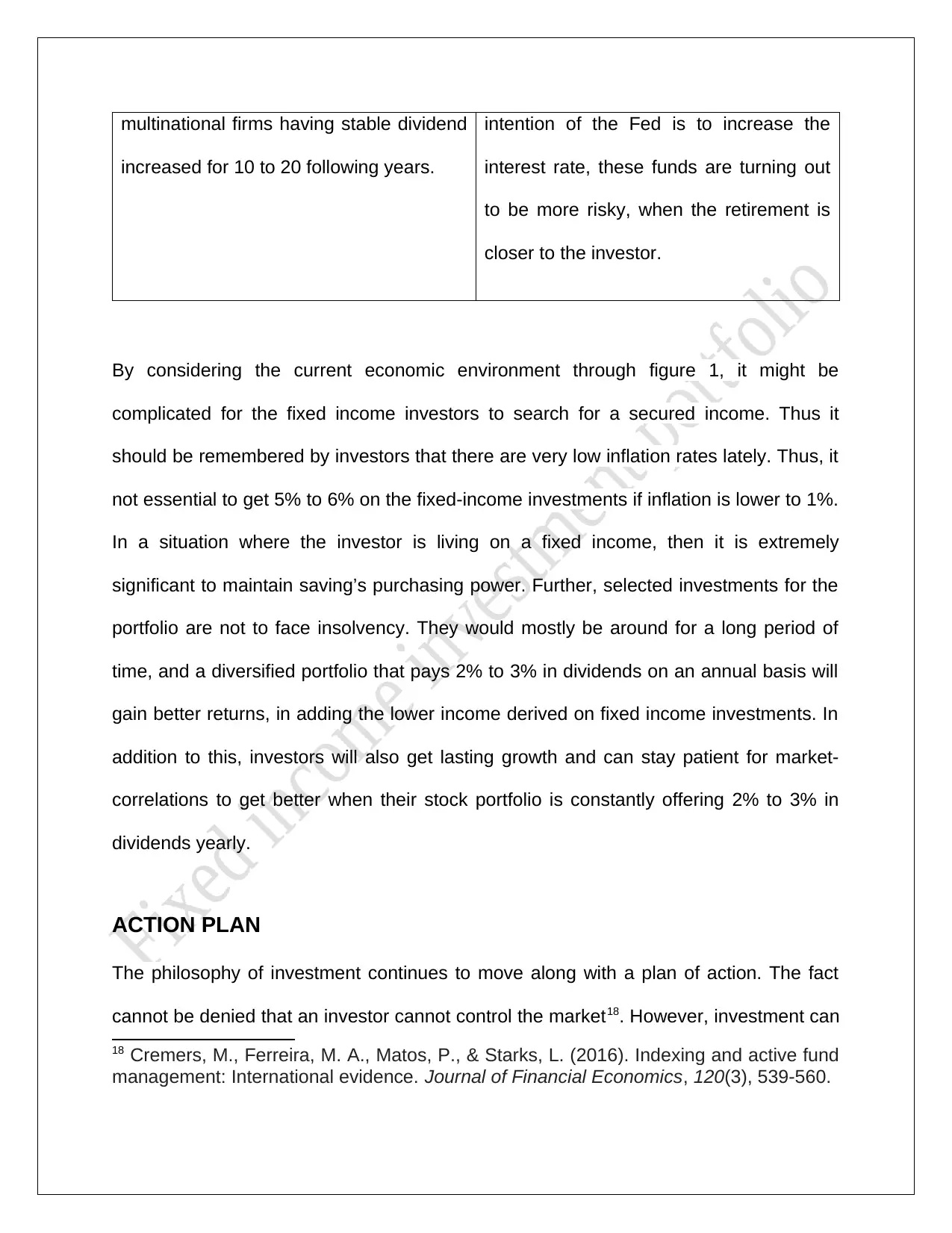
multinational firms having stable dividend
increased for 10 to 20 following years.
intention of the Fed is to increase the
interest rate, these funds are turning out
to be more risky, when the retirement is
closer to the investor.
By considering the current economic environment through figure 1, it might be
complicated for the fixed income investors to search for a secured income. Thus it
should be remembered by investors that there are very low inflation rates lately. Thus, it
not essential to get 5% to 6% on the fixed-income investments if inflation is lower to 1%.
In a situation where the investor is living on a fixed income, then it is extremely
significant to maintain saving’s purchasing power. Further, selected investments for the
portfolio are not to face insolvency. They would mostly be around for a long period of
time, and a diversified portfolio that pays 2% to 3% in dividends on an annual basis will
gain better returns, in adding the lower income derived on fixed income investments. In
addition to this, investors will also get lasting growth and can stay patient for market-
correlations to get better when their stock portfolio is constantly offering 2% to 3% in
dividends yearly.
ACTION PLAN
The philosophy of investment continues to move along with a plan of action. The fact
cannot be denied that an investor cannot control the market18. However, investment can
18 Cremers, M., Ferreira, M. A., Matos, P., & Starks, L. (2016). Indexing and active fund
management: International evidence. Journal of Financial Economics, 120(3), 539-560.
increased for 10 to 20 following years.
intention of the Fed is to increase the
interest rate, these funds are turning out
to be more risky, when the retirement is
closer to the investor.
By considering the current economic environment through figure 1, it might be
complicated for the fixed income investors to search for a secured income. Thus it
should be remembered by investors that there are very low inflation rates lately. Thus, it
not essential to get 5% to 6% on the fixed-income investments if inflation is lower to 1%.
In a situation where the investor is living on a fixed income, then it is extremely
significant to maintain saving’s purchasing power. Further, selected investments for the
portfolio are not to face insolvency. They would mostly be around for a long period of
time, and a diversified portfolio that pays 2% to 3% in dividends on an annual basis will
gain better returns, in adding the lower income derived on fixed income investments. In
addition to this, investors will also get lasting growth and can stay patient for market-
correlations to get better when their stock portfolio is constantly offering 2% to 3% in
dividends yearly.
ACTION PLAN
The philosophy of investment continues to move along with a plan of action. The fact
cannot be denied that an investor cannot control the market18. However, investment can
18 Cremers, M., Ferreira, M. A., Matos, P., & Starks, L. (2016). Indexing and active fund
management: International evidence. Journal of Financial Economics, 120(3), 539-560.
Paraphrase This Document
Need a fresh take? Get an instant paraphrase of this document with our AI Paraphraser
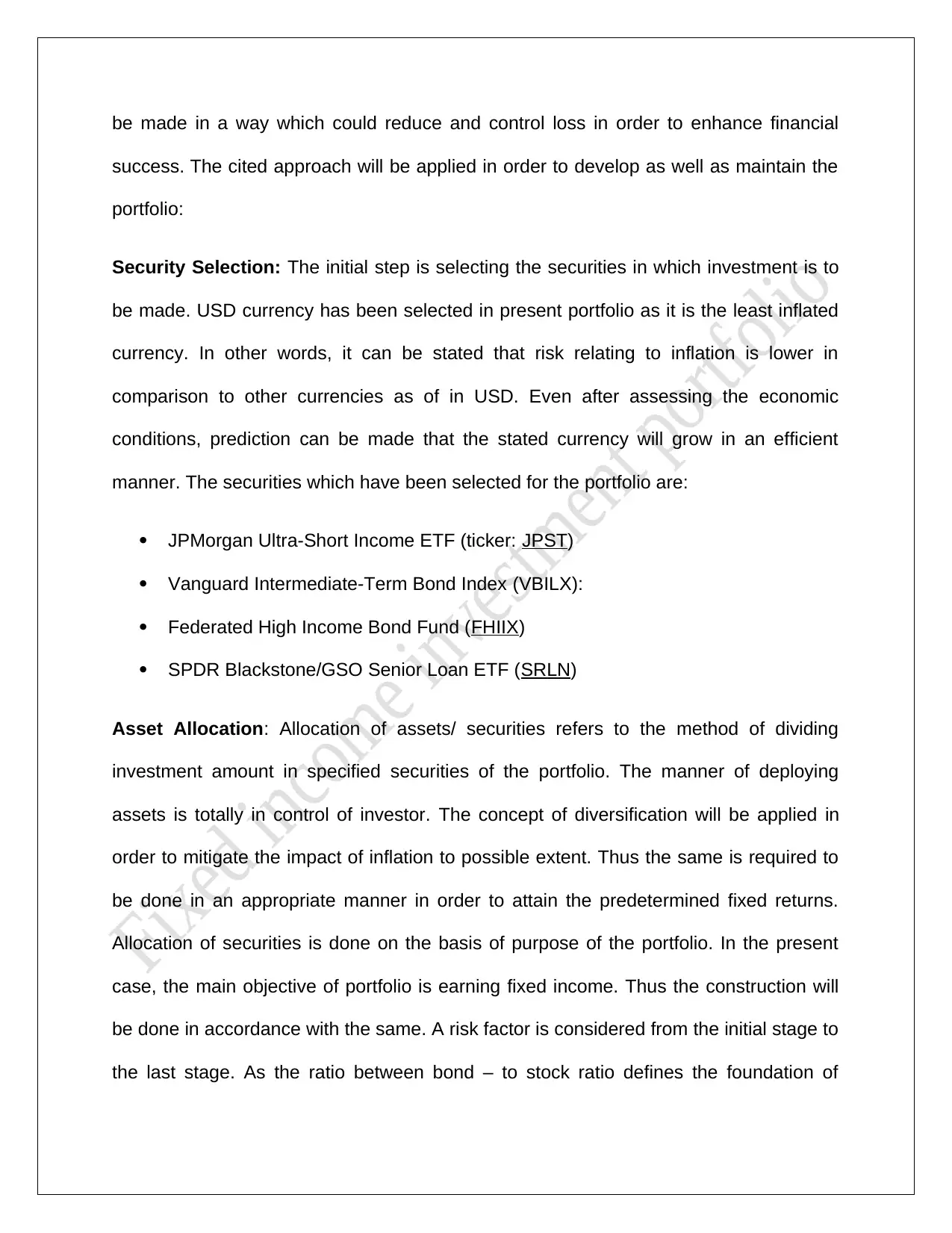
be made in a way which could reduce and control loss in order to enhance financial
success. The cited approach will be applied in order to develop as well as maintain the
portfolio:
Security Selection: The initial step is selecting the securities in which investment is to
be made. USD currency has been selected in present portfolio as it is the least inflated
currency. In other words, it can be stated that risk relating to inflation is lower in
comparison to other currencies as of in USD. Even after assessing the economic
conditions, prediction can be made that the stated currency will grow in an efficient
manner. The securities which have been selected for the portfolio are:
JPMorgan Ultra-Short Income ETF (ticker: JPST)
Vanguard Intermediate-Term Bond Index (VBILX):
Federated High Income Bond Fund (FHIIX)
SPDR Blackstone/GSO Senior Loan ETF (SRLN)
Asset Allocation: Allocation of assets/ securities refers to the method of dividing
investment amount in specified securities of the portfolio. The manner of deploying
assets is totally in control of investor. The concept of diversification will be applied in
order to mitigate the impact of inflation to possible extent. Thus the same is required to
be done in an appropriate manner in order to attain the predetermined fixed returns.
Allocation of securities is done on the basis of purpose of the portfolio. In the present
case, the main objective of portfolio is earning fixed income. Thus the construction will
be done in accordance with the same. A risk factor is considered from the initial stage to
the last stage. As the ratio between bond – to stock ratio defines the foundation of
success. The cited approach will be applied in order to develop as well as maintain the
portfolio:
Security Selection: The initial step is selecting the securities in which investment is to
be made. USD currency has been selected in present portfolio as it is the least inflated
currency. In other words, it can be stated that risk relating to inflation is lower in
comparison to other currencies as of in USD. Even after assessing the economic
conditions, prediction can be made that the stated currency will grow in an efficient
manner. The securities which have been selected for the portfolio are:
JPMorgan Ultra-Short Income ETF (ticker: JPST)
Vanguard Intermediate-Term Bond Index (VBILX):
Federated High Income Bond Fund (FHIIX)
SPDR Blackstone/GSO Senior Loan ETF (SRLN)
Asset Allocation: Allocation of assets/ securities refers to the method of dividing
investment amount in specified securities of the portfolio. The manner of deploying
assets is totally in control of investor. The concept of diversification will be applied in
order to mitigate the impact of inflation to possible extent. Thus the same is required to
be done in an appropriate manner in order to attain the predetermined fixed returns.
Allocation of securities is done on the basis of purpose of the portfolio. In the present
case, the main objective of portfolio is earning fixed income. Thus the construction will
be done in accordance with the same. A risk factor is considered from the initial stage to
the last stage. As the ratio between bond – to stock ratio defines the foundation of
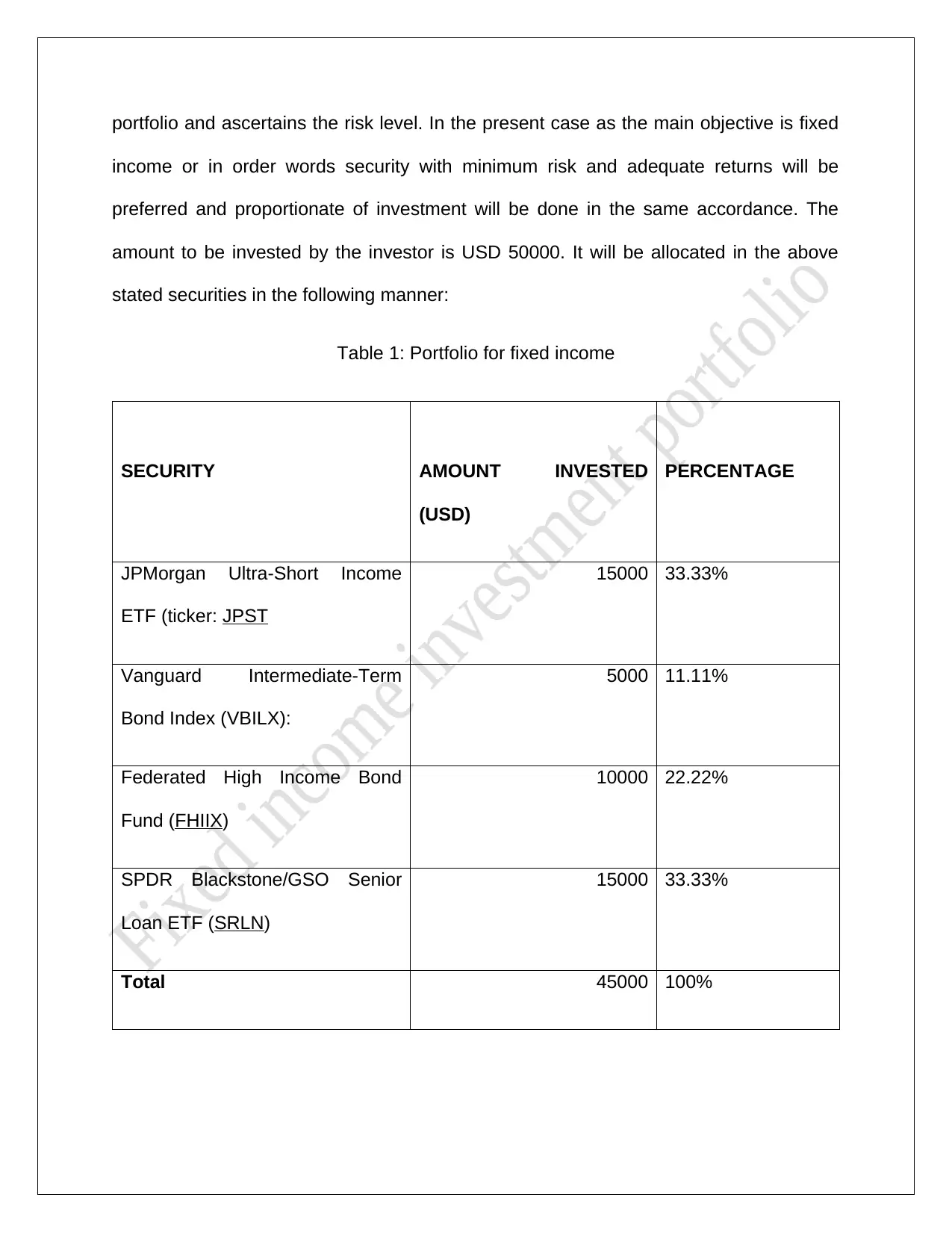
portfolio and ascertains the risk level. In the present case as the main objective is fixed
income or in order words security with minimum risk and adequate returns will be
preferred and proportionate of investment will be done in the same accordance. The
amount to be invested by the investor is USD 50000. It will be allocated in the above
stated securities in the following manner:
Table 1: Portfolio for fixed income
SECURITY AMOUNT INVESTED
(USD)
PERCENTAGE
JPMorgan Ultra-Short Income
ETF (ticker: JPST
15000 33.33%
Vanguard Intermediate-Term
Bond Index (VBILX):
5000 11.11%
Federated High Income Bond
Fund (FHIIX)
10000 22.22%
SPDR Blackstone/GSO Senior
Loan ETF (SRLN)
15000 33.33%
Total 45000 100%
income or in order words security with minimum risk and adequate returns will be
preferred and proportionate of investment will be done in the same accordance. The
amount to be invested by the investor is USD 50000. It will be allocated in the above
stated securities in the following manner:
Table 1: Portfolio for fixed income
SECURITY AMOUNT INVESTED
(USD)
PERCENTAGE
JPMorgan Ultra-Short Income
ETF (ticker: JPST
15000 33.33%
Vanguard Intermediate-Term
Bond Index (VBILX):
5000 11.11%
Federated High Income Bond
Fund (FHIIX)
10000 22.22%
SPDR Blackstone/GSO Senior
Loan ETF (SRLN)
15000 33.33%
Total 45000 100%
⊘ This is a preview!⊘
Do you want full access?
Subscribe today to unlock all pages.

Trusted by 1+ million students worldwide
1 out of 29